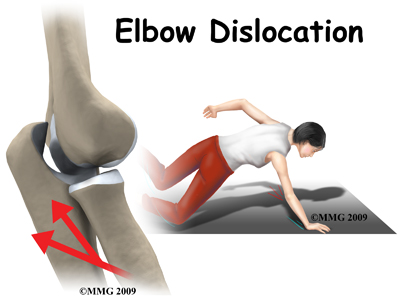
Elbow Dislocation
When the joint surfaces of an elbow are forced apart, the elbow is dislocated. The elbow is the second most commonly dislocated joint in adults (after shoulder dislocations). Elbow dislocations can be complete or partial. A partial dislocation is referred to as a subluxation. The amount of force needed to cause an elbow dislocation is enough to cause a bone fracture at the same time. These two injuries (fracture-dislocation) often occur together.This guide will help you understand:
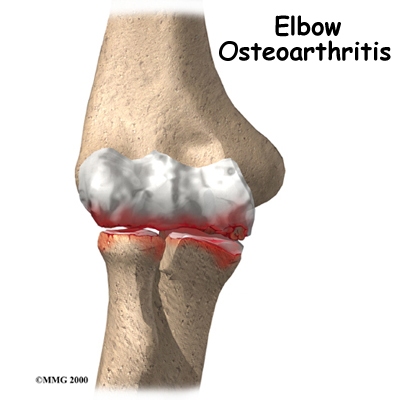
Osteoarthritis of the Elbow Patient Guide
The elbow joint is injured less often than many other joints in the body. The most common injuries of the elbow joint are fractures and dislocations. Fortunately most elbow injuries tend to heal fairly well at the time of injury.Sustaining an elbow injury, however, can lead to problems with the joint later in life. This is true for any injury to a joint but the elbow is one of the joints particularly sensitive to developing problems later on. The initial injury can change the way the joint wo...
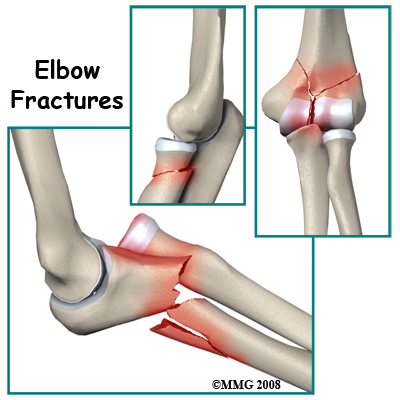
Adult Elbow Fractures
The elbow is a very important region of the arm. It serves as a hinge joint between the upper and lower parts of the arm and allows movements for activities like feeding and lifting. It also allows rotation of the hand and forearm. Together these functions allow us to position the hand in space to perform all its unique and skillful actions. Fractures of the bones that make up the elbow prevent normal movement at the joint and therefore limit the function of the hand, wrist, and forearm. As a re...
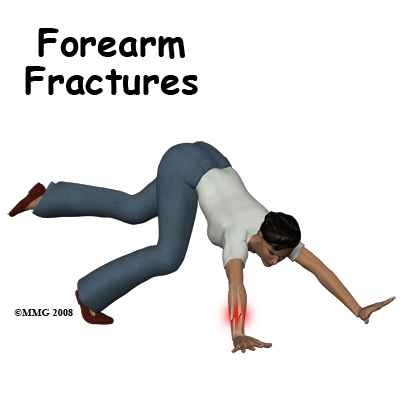
Adult Forearm Fractures
Forearm fractures are those that occur in the middle section (shaft) of the forearm bones. The forearm has a complex anatomy to serve its functions of supporting and positioning the hand in space and providing anchorage for muscles that serve hand function. To fully restore these functions after a forearm fracture the bones must heal in the normal anatomical position.

Adolescent Osteochondritis Dissecans of the Elbow
Physical therapy in Elmhurst & Flushing for Osteochondritis dissecans
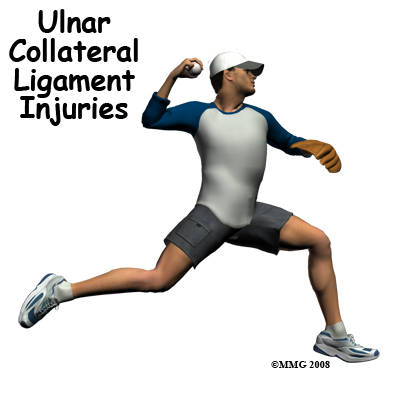
Ulnar Collateral Ligament Injuries
The ulnar collateral ligament (UCL) can become stretched, frayed or torn through the stress of repetitive throwing motions.
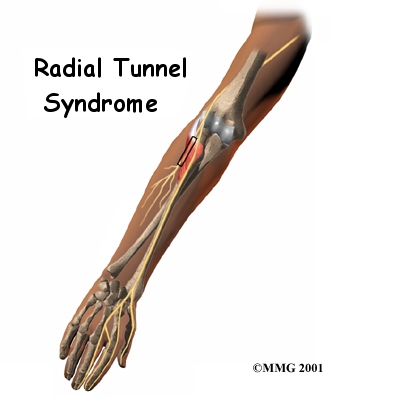
Radial Tunnel Syndrome
Radial tunnel syndrome happens when the radial nerve is squeezed where it passes through a tunnel near the elbow. The symptoms of radial tunnel syndrome are very similar to the symptoms of tennis elbow (lateral epicondylitis). There are very few helpful tests for radial tunnel syndrome, which can make it hard to diagnose.
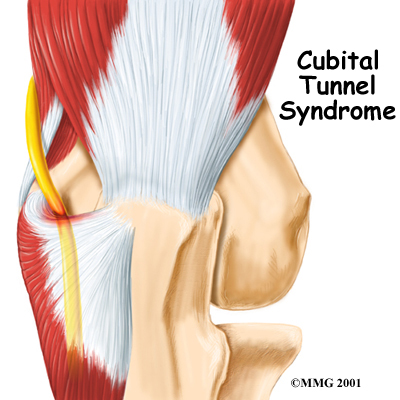
Cubital Tunnel Syndrome
Cubital tunnel syndrome is a condition that affects the ulnar nerve where it crosses the inside edge of the elbow. The symptoms are very similar to the pain that comes from hitting your funny bone. When you hit your funny bone, you are actually hitting the ulnar nerve on the inside of the elbow. There, the nerve runs through a passage called the cubital tunnel. When this area becomes irritated from injury or pressure, it can lead to cubital tunnel syndrome.
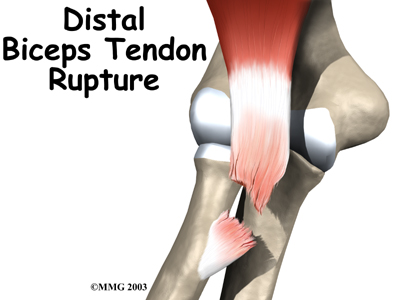
Distal Biceps Rupture
A distal biceps rupture occurs when the tendon attaching the biceps muscle to the elbow is torn from the bone. This injury occurs mainly in middle-aged men during heavy work or lifting. A distal biceps rupture is rare compared to ruptures where the top of the biceps connects at the shoulder. Distal biceps ruptures make up only three percent of all biceps tendon ruptures.
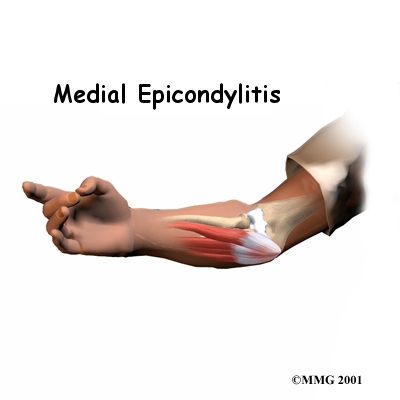
Golfers Elbow (Medial Epicondylitis)
Medial epicondylitis is commonly known as golfer's elbow. This does not mean that only golfers have this condition. But the golf swing is a common cause of medial epicondylitis. Many other repetitive activities can also lead to golfer's elbow: throwing, chopping wood with an ax, running a chain saw, and using many types of hand tools. Any activities that stress the same forearm muscles can cause symptoms of golfer's elbow.
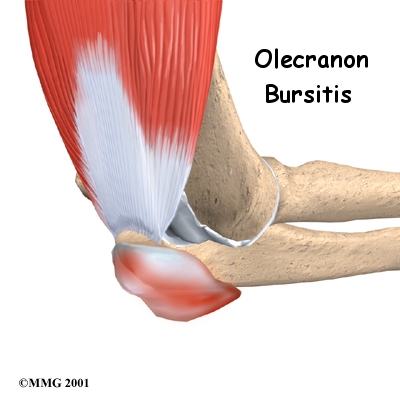
Olecranon Bursitis
Olecranon bursitis is inflammation of a small sac of fluid located on the tip of the elbow. This inflammation can cause many problems in the elbow.
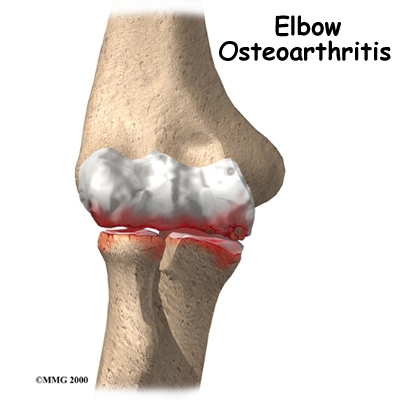
Osteoarthritis of the Elbow
The elbow joint is injured less often than many other joints in the body. The most common injuries of the elbow joint are fractures and dislocations. Most elbow injuries tend to heal pretty well.
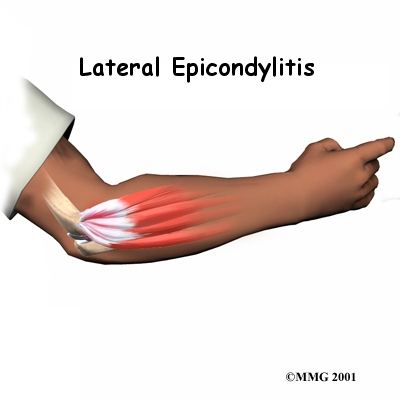
Tennis Elbow (Lateral Epicondylitis)
Lateral epicondylitis, commonly known as tennis elbow, is not limited to tennis players. The backhand swing in tennis can strain the muscles and tendons of the elbow in a way that leads to tennis elbow. But many other types of repetitive activities can also lead to tennis elbow: painting with a brush or roller, running a chain saw, and using many types of hand tools. Any activities that repeatedly stress the same forearm muscles can cause symptoms of tennis elbow.
